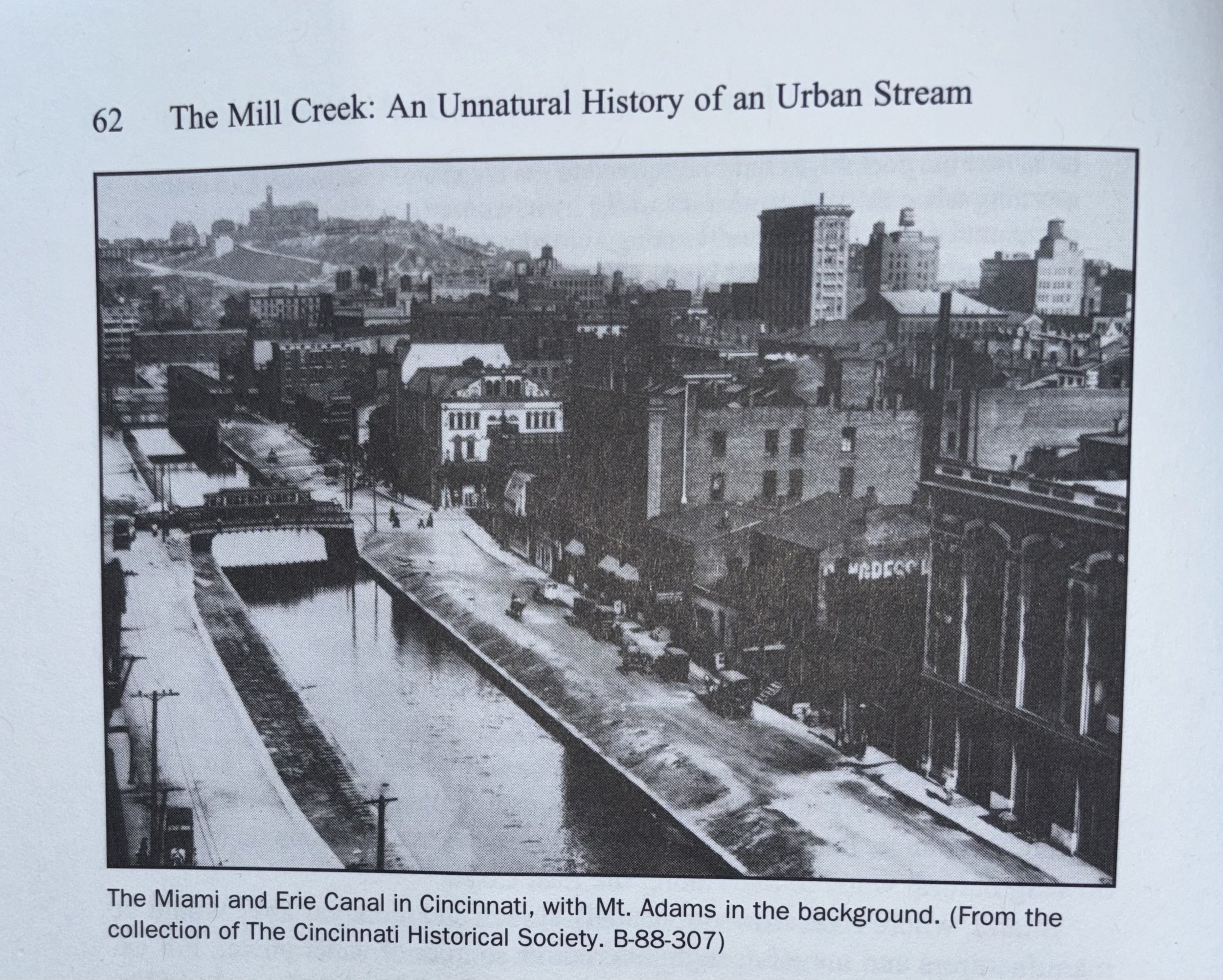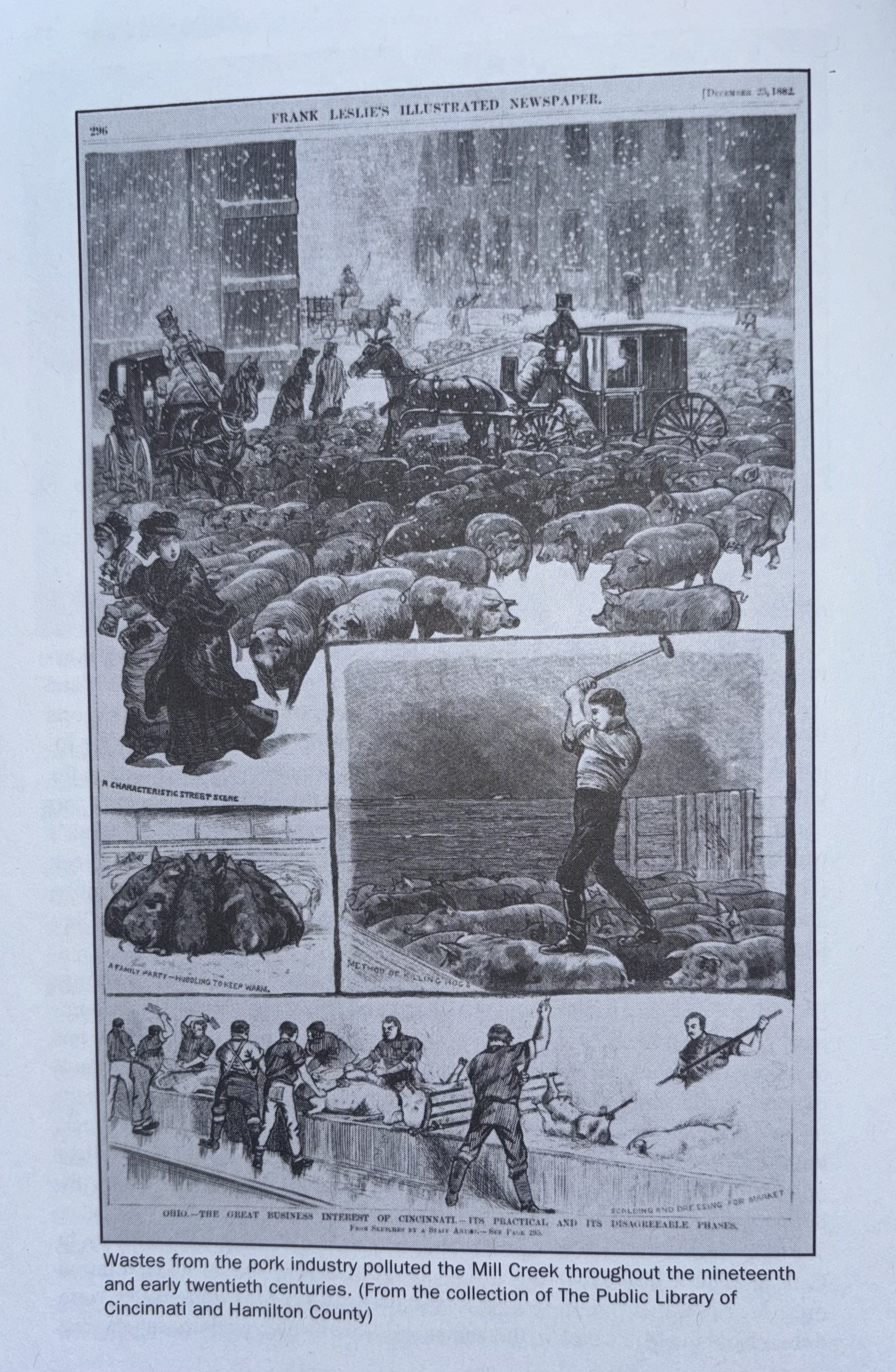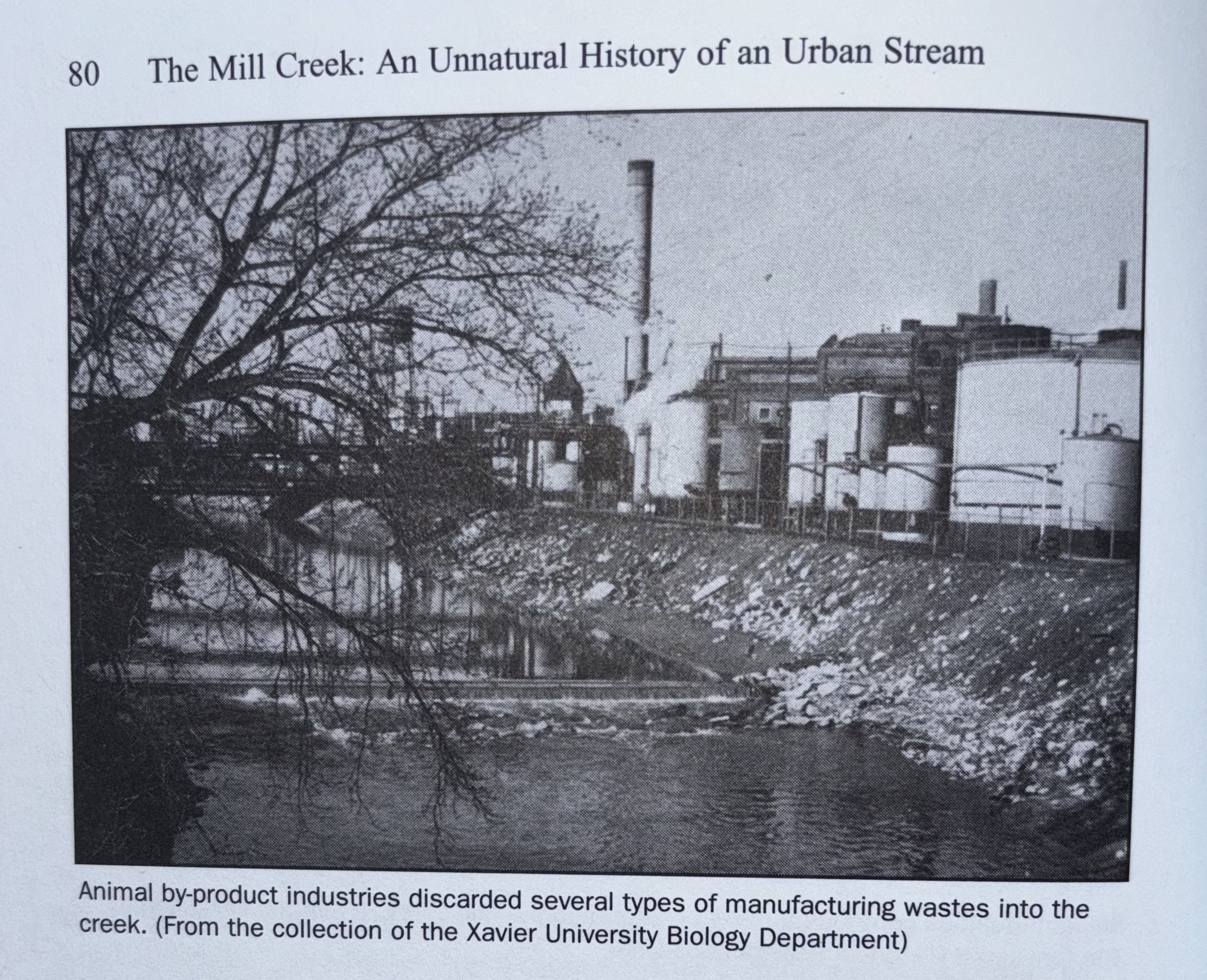by Rufaro Bulathsinghalage, Environmental Education AmeriCorps Member
Industrialization’s Impact on Mill Creek:
Once the Miami, Shawnee and many other Native American tribes were removed from the region, and the waterway was renamed to be more fitting for industry, the Mill Creek changed rapidly and dramatically. The clearing of the Mill Creek Valley began in 1822 with the first two northernmost mills developed and installed in what we now know as West Chester. The novel “The Mill Creek–An Unusual History of an Urban Stream” by Stan Hadeen includes a quote from Lucy Braun–a deciduous forest ecologist. Braun writes that “nothing of the original vegetation of this part remains” and that “it is all farmland” in reference to the Upper Mill Creek Valley. The upland hillside forests were deforested into woodland pastures for livestock (cows, sheep, swine) to graze. The pigs were known to over-graze, constantly overturning the soil, destroying roots and timber in the process.
Decreases in Biodiversity:
Maple, beech, and hickory trees were harvested for firewood while polar and walnut trees were chopped for lumber. The leather industry in Cincinnati boomed, resulting in a high demand for tan bark, so, all oak trees in a 75-100 mile radius were “ruthlessly slaughtered”. By 1881 deforestation had eliminated the woodlands in Hamilton County by 15%.
Not only did the valley’s trees suffer, but so did its wildlife. Mammals such as the black bear, gray wolves, and mountain lions disappeared soon after their forested habitat was destroyed. Fish like the River Chub and the Darter vanished, likely a result of bottom-smothering sedimentation from the destruction of the watershed’s forest cover. Other fish populations became fatigued by over sedimentation of the waterway and likely suffered asphyxiation due to clogged gills, disruption of mating traditions as it became difficult for them to navigate the river, and overall habitat degradation. Macroinvertebrate species decreased and water quality levels plummeted–following was a decrease in their predators, further reducing biodiversity. Deforestation and the cultivation of farmland increased sediment load in the river, decreased animal biodiversity and increased the intensity of various parameters such as temperature, sunlight, nutrients, floods, and droughts. Woodland removal increased summer shoreline and streamwater temperatures, driving away thermally sensitive invertebrates and fish. (Ch. 2-3 in The Mill Creek: An Unnatural History of an Urban Stream by Stan Hadeen book)
Erosion and Flooding:
Deforestation does not go without its consequences–undisturbed forests experience soil erosion rates less than 50 tons/mi2/ year while cleared forests experience soil erosion rates upwards of 10 times that amount. Deforested watersheds are also susceptible to experiencing higher floods of shorter duration. This can be witnessed in the countless and devastating floods that occurred during the 1800s.
1805: Caldwell’s mill in present-day Carthage was swept away in a flood that followed heavy rainfall.
1808: A flood destroyed the first bridge built over Mill Creek.
1822: A 120-foot bridge constructed in 1816 was demolished by a flooded Mill Creek.
(Ch. 2-3 in The Mill Creek: An Unnatural History of an Urban Stream by Stan Hadeen book)
As Cincinnati grew, so did its industry. During the Industrial Revolution, beginning in 1760, Cincinnati became an industrial powerhouse. Mill Creek was a vital resource in its growth, as it provided large, consistent flows of water, driving their machinery. Lockland, a watershed city, even installed a series of four locks that provided water to early factories.
The lush, nutrient-rich floodplains of Mill Creek also attracted agricultural businesses. In the 19th century, many of Ciniannti’s plant and produce products were grown on nearby Mill Creek Valley fields.
‘Porkopolis’ , is a potential catalyst for the devastating dumping that occurred in Mill Creek. Porkopolis was an extremely lucrative business in Cincinnati, however, like many things, it did not come without consequences, in this case–waste. By the early 20th century, Mill Creek waters were discolored by pig blood–a brownish-red effluent that even gave Mill Creek the nickname ‘Bloody Run’. Dairy and other industries also contributed to what seemed to be endless dumping in Mill Creek. Drainage pipes from many of the city’s dairy industries dumped into Mill Creek, while the Mandery Pure Milk Company allowed its waste suds from churning and waste waters to flow down Mill Creek from upstream operations. The Walnut Hills Laundry Company drained roughly 20,000 gallons of wash water into a Mill Creek tributary and two of Locklands paper mills released about 3 million gallons of a “dark brownish black liquid containing much finely divided suspended matter” into the river–just to name a few. (Ch. 6-7 in The Mill Creek: An Unnatural History of an Urban Stream by Stan Hadeen book)
Nonetheless, the city continued to develop and over time one of the valley’s primary hazards continued–flooding. Flooding is something that the Mill Creek Valley had endured for hundreds of years; I even mentioned it when discussing the Native American history in the watershed. Not only were countless bridges destroyed by the floods that followed seasons of heavy rainfall, but the communities that surrounded the river constantly suffered the detrimental effects of severe flooding. In order to combat this, the U.S. The Army Corps of Engineers decided to channelize the river. Channelization is the process of straightening or redirecting natural streams in an artificially constructed stream bed. In theory, channelization has small benefits–it expands the area of fertile land in riparian zones (streambanks); in turn allowing for more efficient and productive farming practices. In the case of Mill Creek, however, channelization was overall a detrimental development of the waterway. In general, some of the drawbacks of channelization are that the channels provide the waterway with less volume to hold excess water during floods, it creates a steeper streambank leading to a faster flow of water running down the banks, which in turn increases erosion and over sedimentation of the waterway. Although the Army Corps of Engineers only met 40% of their goal, these are issues that we continue to combat today.
I know that this seems to be a devastating story of how stewards of the land were pushed out of the Mill Creek Valley, just for its colonizers to develop and destroy the area, but after Mill Creek was named one of the most endangered rivers in North America by the American Rivers in 1997, community members and nonprofits began to shift the current.
After 30 years of dedication, passion, and hard work, Mill Creek has been revitalized as a natural and community asset. With Education programs teaching the community about Mill Creek’s history, Restoration projects finding ways to mitigate the infrastructure that is damaging to the natural ecosystem, Recreation programs to re-connect people to the waterway, and a Water Quality Monitoring program that monitors the health and condition of the waterway–Mill Creek is making its resurgence one day at a time.
Do not allow this story to create a negative image of the waterway and those who contributed to its detriment. Let this be a story of resilience, hope, and inspiration. Empowering you to connect with the river that may lie in your backyard and contribute to the movement that is restoring its vitality. Every step, no matter how small, plays a role in the healing process. The story of Mill Creek is a testament to what can happen when communities come together with a shared vision for restoration and conservation. It’s a reminder that even in the face of adversity, collective action can foster positive change. Now is the time to not only reflect on the past but to look forward to a future where Mill Creek, and waterways like it, thrive once again—nurtured by the very hands that once harmed them. Your involvement matters, and together, we can ensure that the river’s story continues to be one of revival and connection for generations to come.






